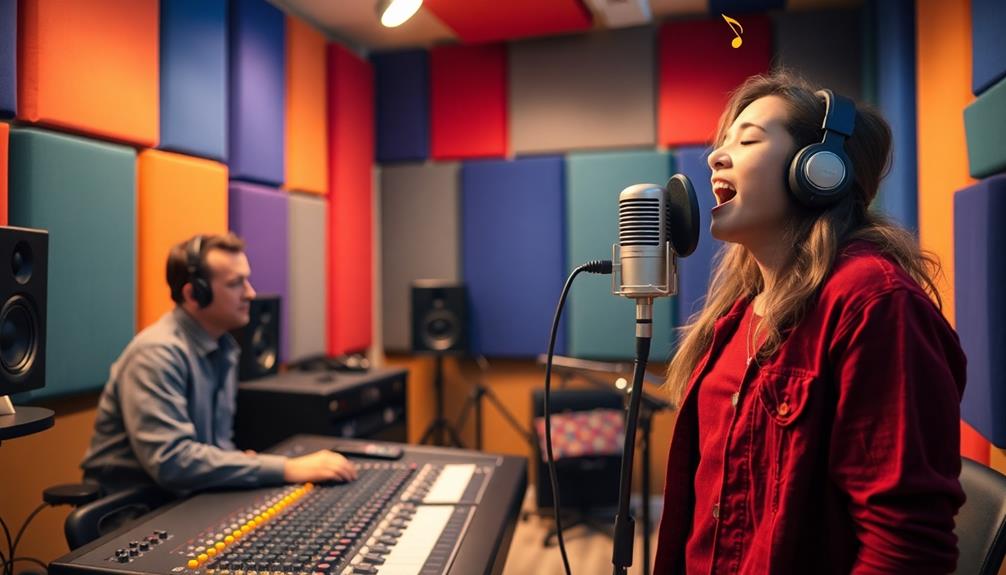Working with vocalists can truly make or break your track, so it's essential to establish trust and rapport first. Start by having open conversations to make them comfortable and respected. Prepare thoroughly by discussing song interpretation and ensuring a quiet, well-equipped recording space. Focus on mic placement and managing headroom to capture the best performance. Encourage vocalists to warm up and express emotions freely; this will enhance their delivery. Finally, master your tracks meticulously for a polished finish. There's a wealth of techniques and insights to explore that can elevate your production even further.
Key Takeaways
- Build trust with vocalists through pre-recording conversations and positive feedback to create a comfortable environment for creativity.
- Prepare lyrics and song structure in advance to streamline the recording process and maintain organization.
- Optimize the recording space with soundproofing and comfort factors to enhance vocal performance and sound quality.
- Maintain proper mic placement and headroom management to ensure natural warmth and prevent distortion in recordings.
- Encourage vocalists to experiment with melodies and emotional delivery to enhance overall performance quality.
Building Trust and Rapport

Building trust and rapport with vocalists is essential for a successful recording session. Establishing a connection through pre-recording conversations helps them feel comfortable, which enhances their performance in the studio.
When you prioritize positive interactions and constructive feedback, you create a fun and productive environment. This fosters collaboration, ultimately improving the quality of the recording.
Vocalists are more likely to open up and experiment with their sound if they feel respected and valued. Acknowledge their expertise, and encourage them to share their ideas and interpretations. This approach not only builds trust but also leads to unique and dynamic results in the final production.
A supportive atmosphere is key. When you prioritize comfort and communication, you facilitate emotional expression, resulting in stronger performances from vocalists.
Remember, building trust isn't just about the technical side; it's about creating an environment where they feel safe to explore their creativity. So, focus on fostering those positive interactions, and watch how it transforms your sessions.
Effective Preparation Techniques
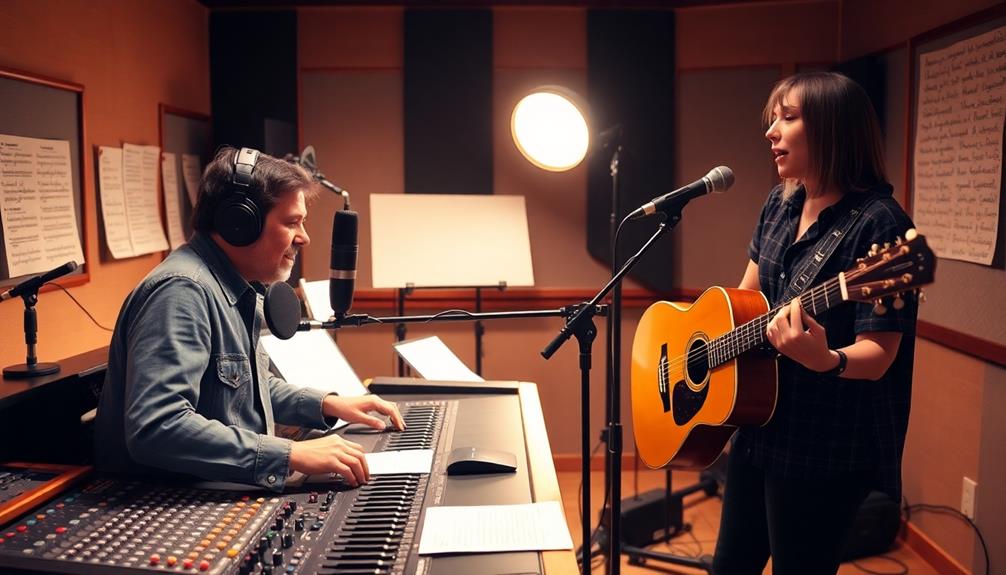
Effective preparation techniques can greatly impact the success of a recording session with vocalists. Start by establishing a clear vision of the desired vocal elements. Discuss song interpretation and emotion, referencing similar tracks to guarantee you're on the same page. This effective communication lays a solid foundation for working together during the vocal recording.
Prepare the lyrics in advance to streamline the process. This shows respect for the vocalist's time and minimizes potential frustrations. Planning the song structure—verses, hooks, and bridges—enhances workflow, making the recording session more organized.
Before the session, take the time to familiarize yourself with the vocalist through conversation. Building rapport increases their comfort and fosters creativity, which is essential in music production.
While you may not be discussing the recording environment yet, remember that a quiet space with soundproofing and acoustic treatment can elevate sound quality.
Creating an Optimal Recording Environment
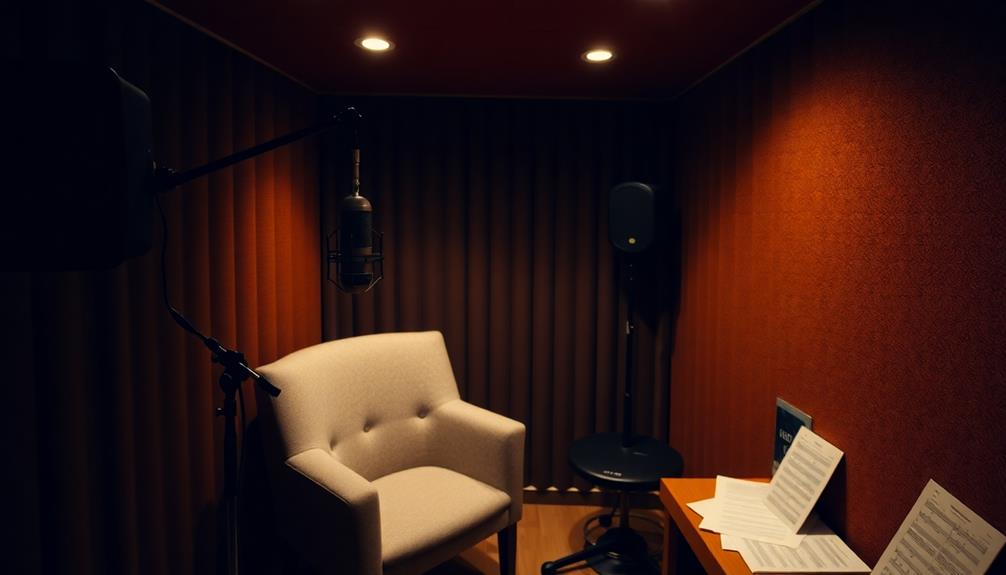
To achieve the best vocal recordings, creating a suitable recording environment is essential. Start by focusing on acoustic treatment to minimize unwanted noise and enhance sound quality. A well-treated room guarantees a clear recording space for vocalists.
Here's how to create an ideal environment for your recording session:
- Use Soundproofing Materials: Invest in soundproofing materials like foam panels or bass traps to block outside noise and prevent sound leakage.
- Choose a Quiet Space: Select a recording area that's free from distractions and external sounds, allowing vocalists to perform without interruptions.
- Arrange Equipment Thoughtfully: Position your equipment and microphone strategically to improve workflow and capture the best sound during recordings.
- Consider Comfort and Atmosphere: Pay attention to lighting, temperature, and seating. A comfortable environment fosters creativity, helping vocalists to deliver their best performance.
Essential Recording Techniques
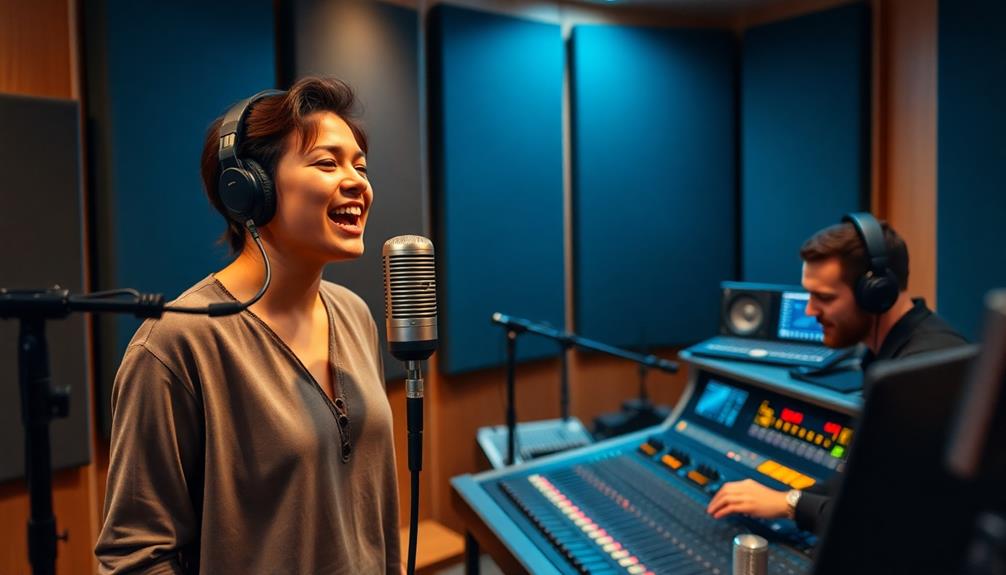
When recording vocals, mic placement plays a key role in capturing the right tone.
You'll want to manage headroom effectively, aiming for a 5-6dB buffer to avoid distortion.
Mic Placement Importance
Understanding the importance of mic placement can drastically improve your vocal recordings. Proper positioning not only enhances tonal quality but also guarantees clarity, allowing for ideal sound capture during vocal production. Here are key tips to take into account:
- Distance Matters: Position the microphone about 6-12 inches from the vocalist's mouth. This distance strikes a balance, reducing proximity effect while capturing the voice's natural warmth.
- Experiment with Angles: Tilting the microphone slightly off-axis can help minimize plosive sounds and sibilance. This technique maintains the presence of the vocals without harshness.
- Choose the Right Mic: Dynamic microphones are great for louder vocals and can be placed closer. On the other hand, condenser microphones usually need a bit more distance for softer singing to avoid distortion.
- Use a Pop Filter: Incorporating a pop filter can greatly reduce plosives. When used alongside proper mic placement, it guarantees cleaner recordings without compromising sound quality.
Headroom Management Essentials
Effective headroom management is fundamental for achieving high-quality vocal recordings. Maintaining an adequate headroom of about 5-6dB during recording helps prevent distortion and preserves vocal quality for the mixing phase. When you keep your input levels well below maximum, you guarantee clean, dynamic sounds that are essential for impactful performances.
Before you start recording, monitor your input levels closely. This practice allows for greater processing flexibility later in the mixing phase, enabling you to make adjustments without risking audio clipping. Consistent headroom practices contribute greatly to the overall recording quality, allowing you to focus on creative elements instead of getting bogged down by technical issues.
Moreover, understanding headroom is critical for all vocalists involved in the process. It fosters a more controlled and professional recording environment, leading to better final mixes. When you prioritize headroom management, you set the stage for a smoother workflow and a more polished sound.
Enhancing Vocal Performance
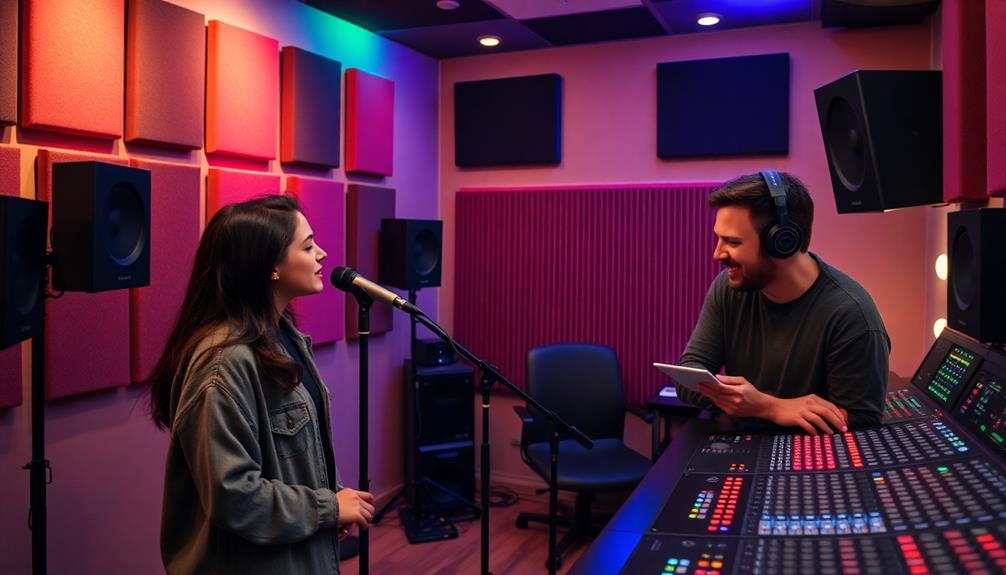
Creating a comfortable recording environment is essential for enhancing vocal performance. When vocalists feel at ease, they can express pitch, tone, and emotion more accurately, resulting in a more natural sound.
Here are four tips to help you elevate their performance:
- Encourage Warm-Up Exercises: Have vocalists perform warm-ups to improve breath control and prevent strain. This can lead to a more stable performance.
- Foster Creativity: Encourage vocalists to experiment with melodies and harmonies. This freedom can yield unique interpretations of the song, enriching the final product.
- Provide Clear Direction: Offer guidance on song interpretation and emotional delivery. This helps vocalists connect with the material, enhancing their performance.
- Emphasize Emotional Expression: Remind vocalists of the importance of conveying emotion and tension in their delivery. This deeper connection can greatly engage the audience.
While using vocal effects and pitch correction can polish the final take, remember that the core of a great vocal performance begins with comfort and confidence in the studio.
Focus on these elements to enhance the overall quality of your recordings.
Post-Production Best Practices
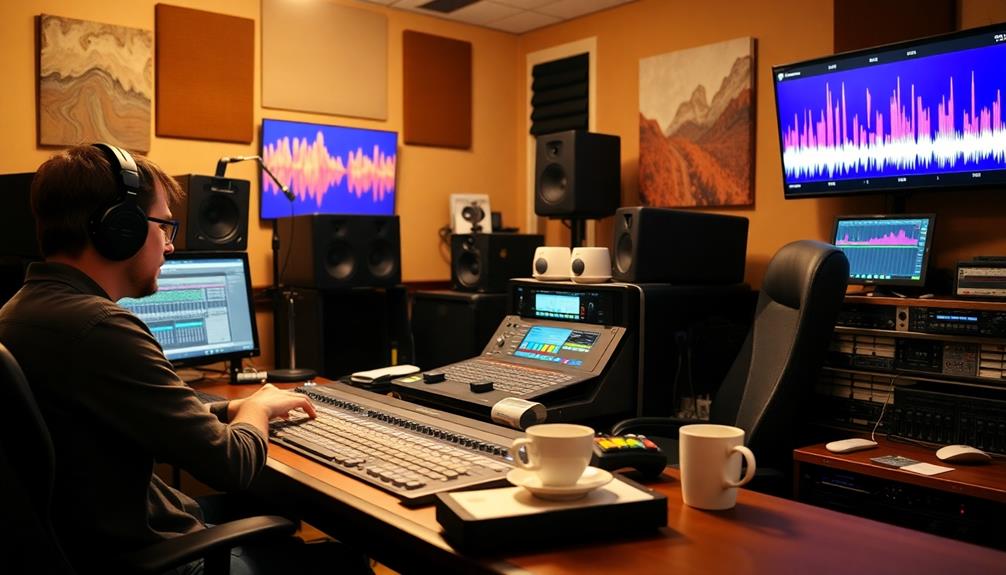
Once you've polished your vocal tracks, mastering is essential for achieving that professional sound you're aiming for.
You'll want to focus on effective distribution strategies to guarantee your music reaches the right audience.
Let's explore how these steps can elevate your final product.
Mastering for Professional Quality
In the final stages of music production, mastering plays an essential role in guaranteeing your track achieves professional quality. It's the step that makes your music shine across various playback systems and formats. To get it right, consider these best practices:
1. Leave Headroom: Make sure your final mix has about -6dB of headroom. This prevents distortion and allows for effective processing during mastering.
Additionally, understanding the financial aspects of production, such as potential IRA investing benefits, can help you allocate resources for high-quality production services.
2. Optimize Processing Vocals: Focus on how your vocals sit in the mix. Use EQ and compression to enhance clarity and presence while removing unwanted frequencies.
3. Utilize Reference Tracks: Compare your track with commercially successful songs in the same genre to align sound quality and tonal balance.
4. Engage a Skilled Mastering Engineer: Their expertise and specialized tools can notably elevate the overall quality of your track, highlighting the nuances that make your music stand out.
Effective Distribution Strategies
How can you guarantee your music reaches the widest audience possible? Effective distribution strategies are key. Start by utilizing music distribution services like DistroKid or TuneCore. These platforms streamline getting your production on major sites like Spotify, Apple Music, and Amazon Music, making it easier for fans to discover your vocal work.
Additionally, consider the importance of timing your releases to coincide with peak listening periods, similar to how SeaWorld operating hours can affect visitor experience.
Next, engage with social media platforms like Instagram and TikTok. These channels let you promote your music through interactive content, allowing direct connections with fans. Craft a compelling brand identity with consistent visuals and messaging, helping your audience connect with your music on a deeper level.
Don't underestimate the power of a well-rounded promotional strategy. Live performances, virtual events, and collaborations with influencers can create buzz around your releases, boosting streaming numbers.
Use email marketing to maintain direct communication with your fans. Regular updates about new releases, merchandise, and shows foster loyalty, ensuring your audience stays engaged.
Frequently Asked Questions
How Do Producers Work With Vocalists?
Producers work with vocalists by creating a comfortable environment, communicating clearly about lyrical intentions, and respecting their input. Regular feedback boosts confidence, leading to better performances and a more dynamic final product that matches their vision.
Do Music Producers Need to Know How Do You Sing?
You don't need to be a songbird to produce music effectively. Understanding vocal techniques, ranges, and emotional delivery helps you guide vocalists, ensuring your collaboration results in a fascinating and harmonious final product.
How Do Artists Find Producers to Work With?
Artists find producers through networking, social media, and online platforms like SoundBetter. Attending local events, getting referrals, or directly reaching out to admired producers can also spark fruitful collaborations that elevate their music projects.
How Do Vocalists Practice?
Did you know that over 75% of vocalists engage in daily warm-up exercises? You practice with lip trills, scales, and backing tracks, while recording sessions help you refine your technique and emotional connection to music.
Conclusion
In the world of music production, working with vocalists is like sculpting a masterpiece; it requires patience, precision, and collaboration. By building trust, preparing thoroughly, and creating the right environment, you can help your vocalist shine. Use essential techniques and enhance their performance to capture the magic in every take. Remember, the real art lies in the details, so embrace post-production with care. Together, you'll craft a vocal track that resonates deeply with listeners.

